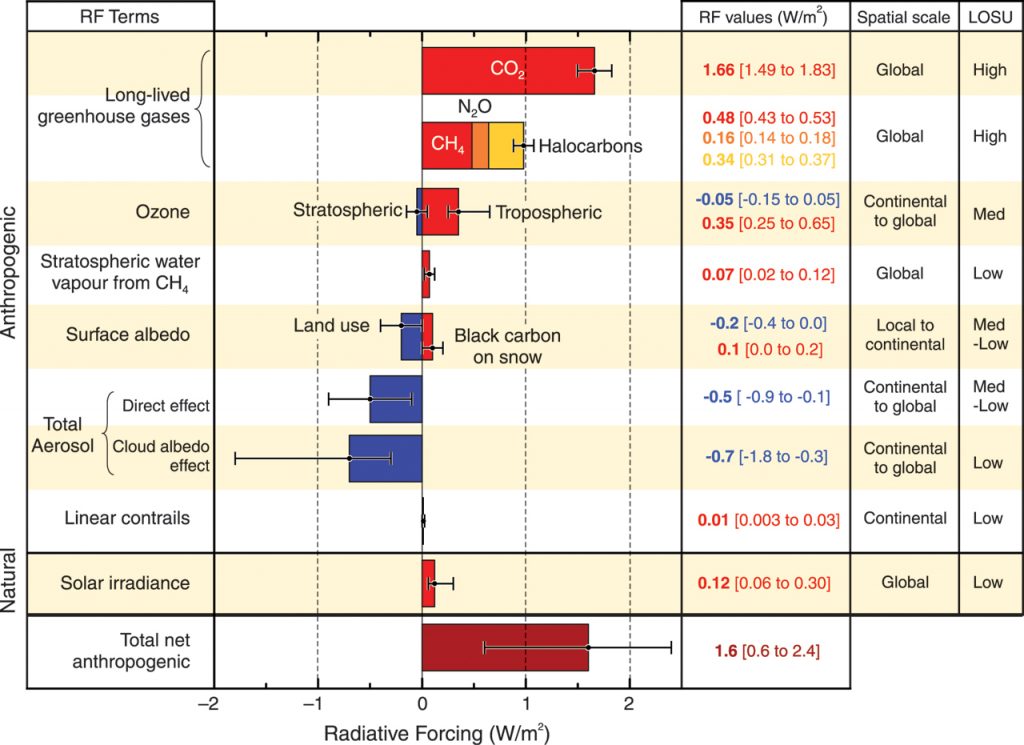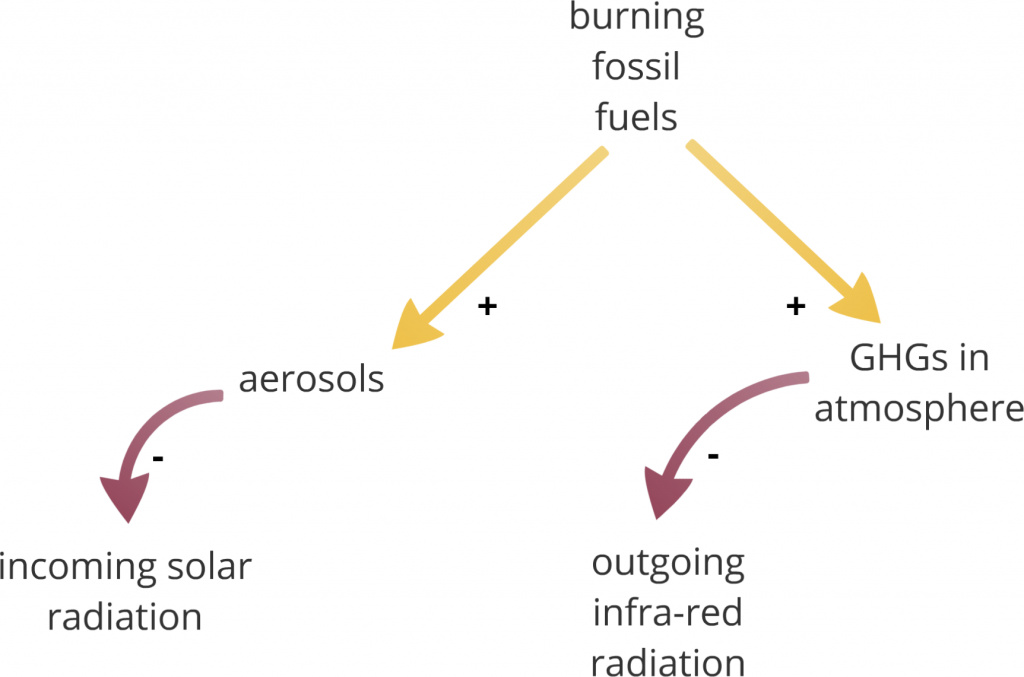The story so far: First, I argued that Climate Science is inherently a Systems Discipline. To develop that idea, I described two important systems as feedback loops: the earth’s temperature equilibrium loop and economic growth and energy consumption. Now it’s time to put those two systems together…
First, we’ll need to capture the unintended consequences of burning fossil fuels for energy, in the form of two distinct kinds of pollution:
Aerosols are tiny particles (smoke, dust, etc) produced when dirtier fossil fuels are burnt, particularly, sulphur dioxide. Coal is the worst for producing these, but oil produces them as well, especially from poorly tuned gasoline and diesel engines. The effect of aerosols is easy to understand, because we can see them. They hang around in the air and block out the light. They contribute to the clouds of smog that hang over our cities in the summer, and they react with water vapour to create sulphuric acid, leading to acid rain. It’s possible to greatly reduce the amount of aerosols produced when we burn fossil fuels, by processing the fuels first to remove the impurities that otherwise would end up as aerosols. For example, low-sulphur coal is much “cleaner” than regular coal, because it produces very few aerosols when you burn it. That’s good for our air quality.
Greenhouse gases include carbon dioxide, methane, water vapour, and a number of other gases such as Chlorofluorocarbons (CFCs). By volume, CO2 is by far the most common byproduct from fossil fuels, although some of the rarer gases actually have a larger “greenhouse effect”. Some greenhouse gases are “short-lived”, because they are chemically unstable, and break down fairly rapidly (for example, carbon monoxide). Others are “long-lived” because they are very stable. For example, carbon dioxide stays in the atmosphere for thousands of years. Unfortunately, we can’t remove these compounds before we burn fossil fuels, because fossil fuels are primarily made of carbon, and it is the carbon that makes them useful as fuels. So, unlike sulphur, you can’t “clean up” the fuel first. When the coal industry talks about “clean coal” these days, they don’t mean the coal itself is clean; they mean they’re working on technology to capture the CO2 after it is produced, but before it disappears up the chimney. Whether this can work cost-effectively on a large scale is an open question.
These two pollutants have opposite effects on the climate system, because each blocks a different part of the spectrum. Aerosols block visible light, and hence reduce the incoming sunlight (like adding a sunshade). Greenhouse gases block infrared radiation, and hence reduce the outgoing radiation from the planet (like adding an extra blanket):
Now when we look at these two effects in the context of all the feedback loops we’ve explored so far, we get the following:
So aerosols reduce the net radiative forcing (causing cooling), and greenhouse gases increase it (causing warming). The earth’s energy balance loop means that each time the concentrations of aerosols and greenhouse gases in the atmosphere change, the earth will change its temperature until all the forces balance out again. Unfortunately, the reinforcing loop that drives energy consumption means that the concentrations of these pollutants are continually changing, and they’re changing at a rate that’s faster than the earth’s balancing loop can cope with. We already noted that the earth’s balancing loop can take several decades to find a new equilibrium. If we were able to “turn off the tap”, so that we’re not adding any more of these pollutants (but we leave the ones that are already in the atmosphere), we’d find the earth’s temperature continues to change.
Which one is winning? Satellites allow us to measure the different effects fairly accurately, and observations from the pre-satellite era allow us to extrapolate backwards, so we can estimate the total effect of each from pre-industrial times to the present. Here’s a chart summarizing the effects:

Total Radiative Forcing from different sources for the period 1750 to 2005. From the IPCC Fourth Assessment Report (AR4).
Note that aerosols have two different effects. The direct effect is the one we described in the system diagram above – it blocks incoming sunlight. The indirect effect is because aerosols also interact with clouds. We’ll explore the indirect effect in a future post. However we look at it, the greenhouse gases are winning, by a large margin. That should mean the planet is warming. And it is:

Land-surface temperatures from 1750-2005, from the Berkeley Earth Surface Temperature project (click for original source)
Note the steep rise from the 1980s onwards, and compare it to the exponential curve of greenhouse gas emissions we saw earlier. More interestingly note the slight fall in the immediate postwar period (1940s to 1970s). One hypothesis for this is that during this period the sulphate aerosols were winning. There’s some uncertainty about the exact size of the aerosol effect during this period (note the size of the ‘uncertainty whiskers’ on the bar graph above). However, it’s true that concern about acid rain led legislation and international agreements in the 1980s to reduce sulphate emissions from fossil fuels.
The fact that sulphate aerosols have a cooling effect that can counteract the warming effect from greenhouse gases leads to an interesting proposal. If we can’t reduce the amount of greenhouse gases we emit, maybe instead we can increase the amount of sulphate aerosols. This has been studied as a serious geo-engineering proposal, and could be done quite cheaply, although we’d have to keep pumping up more of the stuff, as it washes out of the atmosphere fairly quickly. Alan Robock has identified 20 reasons why this is a bad idea. But really, we only need to know one reason why it’s a silly idea, and that comes directly from our analysis of the feedback loops in the economic growth and energy consumption system. As long as that loop is producing an exponential growth in greenhouse gas emissions, any attempt to counter-act them would also have to grow exponentially to keep up. The dimming effect from sulphate aerosols will affect many things on earth, including crop production. Committing ourselves to a path of exponential growth in sulphate aerosols in the stratosphere is quite clearly ridiculous. So if we ever do try this, it can only ever be a short-term solution, perhaps to buy us a few years to get the growth in greenhouse gases under control.
One other comment about the system diagrams we’ve created so far. Energy is mentioned twice in the diagrams: once in the loop describing economic growth, and once in the earth’s energy balance loop. We can compare these two. In the top loop, the current worldwide energy consumption by humans is about 16 terawatts. In the bottom loop, the current amount of energy being added to the earth due to greenhouse gases is about 300 terawatts. So the earth is currently gaining about 18 times the amount of energy that the entire human race is actually using. (Here’s how this is calculated).
Finally, note that although the diagram contains four different feedback loops, none of these are what climate scientists mean when they talk about feedbacks in the climate system. To understand why, we have to make a distinction between the basic operation of the system I’ve described so far (which drives global warming), and additional chains of cause-and-effect that respond to changes in the basic system. Climate scientists study these additional loops, because it’s these additional loops that determine how much warming we should expect from any specific amount of greenhouse gases. If you start warming the planet, using the system we’ve described so far, there are many other consequences. Some of those consequences can come back to bite you as reinforcing feedbacks. We’ll start looking at these in the next post.
Other posts in this series, so far:




Pingback: The Climate as a System, part 2: energy consumption | Serendipity
Pingback: Another Week of Climate Instability News, September 1, 2013 – A Few Things Ill Considered
Pingback: The Climate as a System, part 4: earth system feedbacks | Serendipity
Pingback: What Does the New IPCC Report Say About Climate Change? | Serendipity
Pingback: Warming Slowdown? (Part 1) | Azimuth
Pingback: Why Systems Thinking? | Serendipity